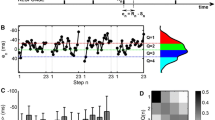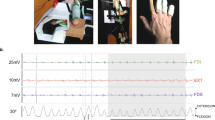Abstract.
The phase-resetting experiment was applied to human periodic finger tapping to understand how its rhythm is controlled by the internal neural clock that is assumed to exist. In the experiment, the right periodic tapping movement was disturbed transiently by a series of left finger taps in response to impulsive auditory cues presented randomly at various phases within the tapping cycle. After each left finger tap, the original periodic tapping was reestablished within several tapping cycles. Influences of the disturbance on the periodic right finger tapping varied depending on the phase of the periodic right finger tapping at which each left finger tap was made. It was confirmed that the periodic tapping was disturbed not by the auditory cues but by the left finger taps. Based on this fact, in this paper each single left tap was considered as the stimulus, and the phase of the periodic tapping of the right index finger when the left tap was executed as the phase of the stimulus. Responses of the neural activities (magnetoencephalography, MEG), the tapping movement, and the corresponding muscle activities (electromyography) were simultaneously measured. Phase-resetting curves (PRCs) representing the degree of phase reset as a function of the phase of the stimulus were obtained both for the left sensorimotor cortex MEG response and for the right index finger tapping response. The shapes of both PRCs were similar, suggesting that the phase reset of the left sensorimotor cortex activities and that of the finger tapping rhythm were the same. Four out of eight subjects showed type-0 reset in Winfree's definition, and the others showed type-1 reset. For general limit-cycle oscillators, type-0 reset is obtained for relatively strong perturbations and type 1 for weak perturbations. It was shown that the transient response of MEG to the single left tap stimuli in type-0 subjects, where the phase was progressively reset, were different from those in type-1 subjects. Based on detailed analysis of the differences, a neural network model for the phase reset of the tapping rhythm is proposed.
Similar content being viewed by others
Author information
Authors and Affiliations
Additional information
Received: 10 February 2000 / Accepted in revised form: 15 January 2002
Rights and permissions
About this article
Cite this article
Yoshino, K., Takagi, K., Nomura, T. et al. MEG responses during rhythmic finger tapping in humans to phasic stimulation and their interpretation based on neural mechanisms. Biol Cybern 86, 483–496 (2002). https://doi.org/10.1007/s00422-002-0314-5
Issue Date:
DOI: https://doi.org/10.1007/s00422-002-0314-5




